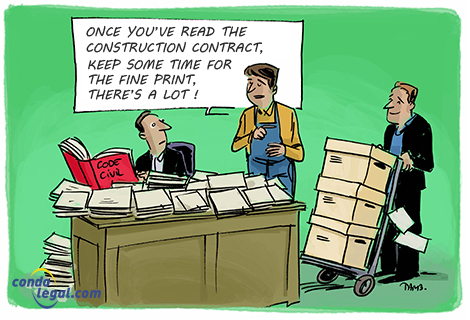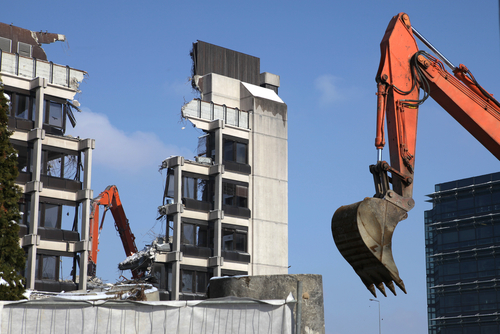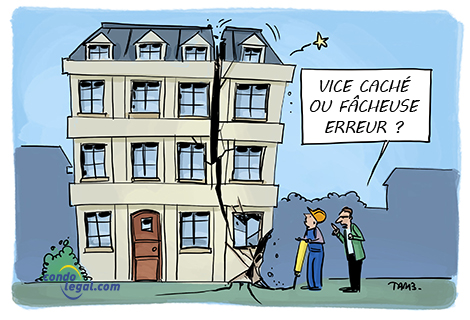.png) The law regulates the liability of contractors and building professionals for any problem related to the quality of construction work. In this regard, the legislator has provided for a specific protection regime for divided co-ownership. Section 1081 of the Civil Code of Québec recognizes the legal interest of any syndicate of co-owners to assert the rights of all co-owners to correct defects that appear, in the short or long term. This could occur during the initial construction of the building, or during work carried out several years after its erection. In short, when problems affect the common portions, the syndicate benefits from several legal warranties. Among them is the one against latent defects, design or construction defects. These warranties are worth their weight in gold, because very often, the cost of the work to be carried out in a co-ownership can be substantial.
The law regulates the liability of contractors and building professionals for any problem related to the quality of construction work. In this regard, the legislator has provided for a specific protection regime for divided co-ownership. Section 1081 of the Civil Code of Québec recognizes the legal interest of any syndicate of co-owners to assert the rights of all co-owners to correct defects that appear, in the short or long term. This could occur during the initial construction of the building, or during work carried out several years after its erection. In short, when problems affect the common portions, the syndicate benefits from several legal warranties. Among them is the one against latent defects, design or construction defects. These warranties are worth their weight in gold, because very often, the cost of the work to be carried out in a co-ownership can be substantial.
Liability of the syndicate
Section 1039 of the Civil Code of Québec states that the purpose of the syndicate is the preservation of the immovable, the maintenance and administration of the common portions, the protection of the rights appurtenant to the immovable or the co-ownership, as well as all the business in the common interest. Section 1077 of the Civil Code of Québec adds, for its part, that "the syndicate is liable for damage caused to the co-owners or third persons by faulty design, construction defects or the lack of maintenance of the common portions, without prejudice to any recursory action’’. As a result, the syndicate is subject to a no-fault liability regime, as it is responsible for the preservation of the immovable and the maintenance of its common portions.
Legal recourse of the syndicate (common portions)
In the event of a construction defect affecting the common portions of the immovable, it is the responsibility of the syndicate to put on notice and hold liable the authors of these defects. The law has clearly granted it the power, the quality and the legal interest to institute any necessary legal action, regarding defects and deficiencies affecting the common portions of the immovable. Section 1081 of the Civil Code of Québec deals with the terms and conditions of an action based on a latent defect, a faulty design or construction defect, as well as a defect in the ground.
This legal action can be brought against:
Legal action of the syndicate (private portions)
The syndicate may also bring a legal action based on a defect affecting private portions, if it has obtained the authorization of the co-owners concerned. When many of them suffer similar or identical damage in their private portion, it is often more practical and economical to act through the syndicate.
Notice within a reasonable time
But before taking any action, the board of directors must first give notice of the problem to the persons concerned (e.g., contractor, architect and engineer) in writing and with diligence. In the case of latent defects, it is in principle required to do so no later than six months after their discovery. This requirement is intended to inform the person to be held responsible that work has yet to be completed, or that some of it is non-compliant. This will give those persons involved a chance to inspect the problems, on site and as quickly as possible, and to carry out the corrective work (if necessary).
Demand letter
If there is no response to this notice, or a refusal to act on it, the syndicate must then send a demand letter to the persons concerned, to summon them to honour their obligations. Usually, this letter is accompanied by a report written by a building professional describing the defects. It will also provide for a period during which repairs must be carried out, at the expense of the persons responsible. If no action is taken, the syndicate will have the corrective work carried out itself. It will then claim the expenses incurred, by means of an appropriate recourse. Take note that it is possible to merge, in the same document, the notice of a defect which would include the request to remedy it (demand letter).
Newly created co-ownership
In the case of a recent co-ownership, it is the responsibility of the new board of directors of the syndicate to ensure, following the loss of control (50% +1) of the developer over the co-ownership, that the building is free of deficiencies or defects. It will ensure this by requesting the services of building professionals, in order to carry out a visual inspection of the building and its components. This approach should never be ruled out by the syndicate or its directors, on the pretext that the building is new or under "warranty".
In addition, it should be noted that the six-month period for providing a notice of a latent defect must be respected, at all costs, as this could affect the very existence of a right of action. This period begins to run from the day of the election of the new Board of Directors, which succeeds that of the interim director.
Co-ownership (syndicate) undertakes the work
When a syndicate of co-ownership undertakes work in the common portions, it acts as a project manager, since it is its instigator and beneficiary. It is therefore the one who defines the specifications and therefore the needs, the budget, the provisional timetable and the objectives to be achieved. This may include repairs or replacements of common portions, or alterations to the immovable. This work could also have defects, hence the need to be vigilant.
Once the work completed, the Board of Directors proceeds with its acceptance and may express reservations. The acceptance will validate (or not) the conformity of the work specified in the contractor’s contract, as well as its execution according to the established terms and conditions. If it does not meet these criteria, the syndicate must use the warranties at its disposal. In addition, it should be noted that the acceptance of the work by the syndicate marks the starting point of the legal warranty relating to poor workmanship.
Asserting its rights
If the syndicate does not obtain satisfaction after sending a notice and a demand letter, the time has come to take legal action or assert its rights, if necessary, under a compulsory or optional guarantee plan. But it will need to be knowledgeable with the different types of recourses available. If necessary, a syndicate should retain the services of a lawyer experienced in co-ownership law. The latter will be able to act as an advisor, regarding the legal options that can be used.
 WHAT YOU SHOULD KNOW ! Defects affecting the immovable due to deficient work should not be confused with the syndicate's obligation to maintain common portions. By having an inspection of the immovable carried out by a building professional, as well as sending a notice, it will in particular avoid a possible defense to its lawsuit, in which the author of the deficiencies could argue that it was, in fact, caused by a lack of maintenance attributable to the syndicate.
WHAT YOU SHOULD KNOW ! Defects affecting the immovable due to deficient work should not be confused with the syndicate's obligation to maintain common portions. By having an inspection of the immovable carried out by a building professional, as well as sending a notice, it will in particular avoid a possible defense to its lawsuit, in which the author of the deficiencies could argue that it was, in fact, caused by a lack of maintenance attributable to the syndicate.
 WHAT TO KEEP IN MIND : Under section 1077 of the Civil Code of Québec, the syndicate is liable (by sole effect of the law) for damages caused to co-owners or third parties by faulty design or construction defects of the immovable, even if they occurred prior to the institution of the co-ownership (publication of a declaration of co-ownership), but also for damages caused to co-owners or third parties by its own failure to maintain the common portions.
WHAT TO KEEP IN MIND : Under section 1077 of the Civil Code of Québec, the syndicate is liable (by sole effect of the law) for damages caused to co-owners or third parties by faulty design or construction defects of the immovable, even if they occurred prior to the institution of the co-ownership (publication of a declaration of co-ownership), but also for damages caused to co-owners or third parties by its own failure to maintain the common portions.
 WARNING ! The syndicate must act within the period of time provided by law, failing which its legal action could be declared inadmissible. Only the filing of a judicial proceeding interrupts the extinctive prescription period applicable to each warranty. It should be remembered that a letter of demand does not have the effect of interrupting this period. Some unscrupulous entrepreneurs will therefore have a strong interest in being slow to react to them, which is why vigilance is essential.
WARNING ! The syndicate must act within the period of time provided by law, failing which its legal action could be declared inadmissible. Only the filing of a judicial proceeding interrupts the extinctive prescription period applicable to each warranty. It should be remembered that a letter of demand does not have the effect of interrupting this period. Some unscrupulous entrepreneurs will therefore have a strong interest in being slow to react to them, which is why vigilance is essential.




.png)


